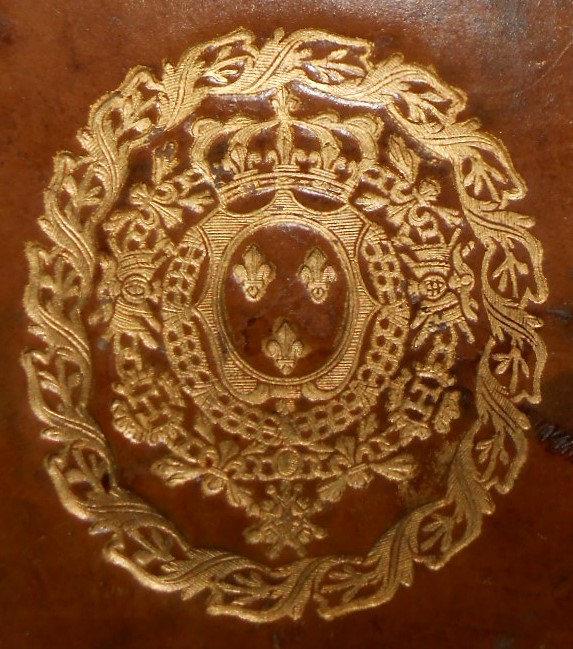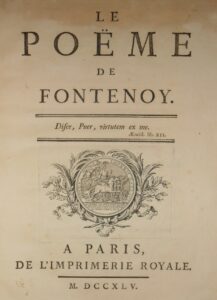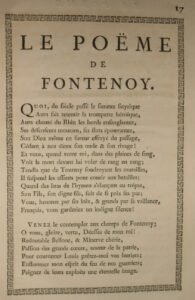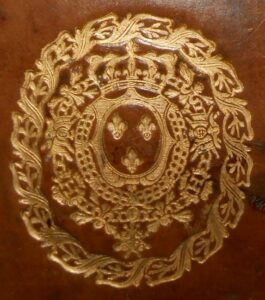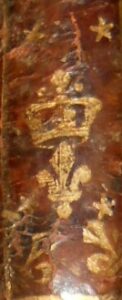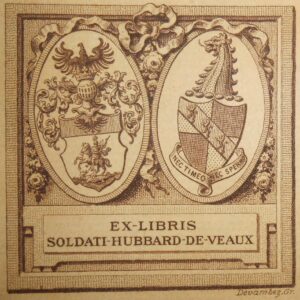Voltaire. Le Poëme de Fontenoy. Paris, Imprimerie royale, 1745. In-4°. 28 pp. Engraved vignette on the title, the poem (pp. 16 to 28) in a Greek frame. Contemporary full marbled fawn calf, spine with 5 raised bands decorated with gilt fleur-de-lys and royal crowns, fawn morocco title-piece, gilt coat-of-arms on covers framed by a gilt fillet, gilt fillet on edges, gilt roulette on covers, gilt edges (Du Seuil or Padeloup?).
Only 600 copies of “this small monument, as Voltaire wrote, that I have erected to the glory of our monarch”, were printed, this bound with the royal coat of arms.
On 1 April, Voltaire had been appointed historiographer to the king, and when he heard the news of the victory at Fontenoy on 11 May over the troops of the United Provinces, Great Britain, Hanover and the Austrian Empire, he was “deliriously happy”, as he wrote to the Marquis d’Argenson a few days later. So he published a draft of this poem, which went through more than 9 editions that year, in Paris and in the provinces, often augmented with verse, notes and even a plan in the third edition.
Voltaire told the comte de Tressan on 17 June 1745: “A seventh edition will be produced in Paris, and perhaps in the Louvre: it is dedicated to the king, and his kindness in accepting this tribute sets the seal on the authenticity of the play”. The author wanted a limited print run of this luxurious royal edition, as Maurepas wrote in June 1745 to Anisson, director of the Imprimerie Royale: “The King has agreed that the poem written by M. de Voltaire on the victory won by His Majesty at Fontenoy should be printed in the Louvre, and that only six hundred copies should be printed, as M. de Voltaire requested; as he will no doubt see you on this subject, you will please take the necessary steps for this printing.”
Voltaire devoted chapter XV of his Précis du Siècle de Louis XV to this battle, “its importance, the danger to the King and the Dauphin, demanded it. This action decided the fate of the war, prepared for the conquest of the Netherlands, and served as a counterweight to all the unfortunate events. What makes this battle forever memorable is that it was won when the general, weakened and almost expiring, could no longer act. Marshal de Saxe had made the arrangements, and the French officers won the battle.”
The title vignette is an antique medal depicting Louis XV on a quadriga crowned by a winged Victory.
The royal arms are listed by O.H.R. as those of Louis XIV which continued to be used under Louis XV, some in a reduction “of a slightly rounder shape, 54 x 46 mill. [which is the case here], which was not seen before the reign of Louis XV”. These bindings are very similar to those of the copies in the National Library of Naples and the National Library of the Netherlands respectively. No doubt entrusted to the care of the royal bookbinders, Du Seuil and Padeloup, these copies were intended as magnificent gift books to the glory of the victorious monarch.
Handwritten bookplate of a “Lecomte daughter, aged 18, living in Mante […]“. Could she be related to Marguerite Lecomte, whom Maurice Quentin de La Tour painted in 1753? Born Josset, on 9 September 1735, at the age of 18, she married a 33-year-old Procureur du Châtelet, Jacques Roger Lecomte, born on 27 February 1702 in Mantes-la-Jolie. A pastellist, she had a long and passionate relationship with Claude Watelet. From the Soldati Hubbard de Veaux library, with his engraved bookplate.
Bengesco, Voltaire, Bibliographie de ses œuvres, tome I, n° 611 ; O. H. R., pl. 2494, variant of tool n°2 of the tool n°10.
The upper cover has 4 small wormholes and a small worm’s work on the arms, not serious, large epidermis on the lower cover, a few stains on the covers, epidermis on the spine, corners and headpieces restorated, a few marginally browned leaves, including the title.
A good copy, however, of a rare edition.
1 500 €
